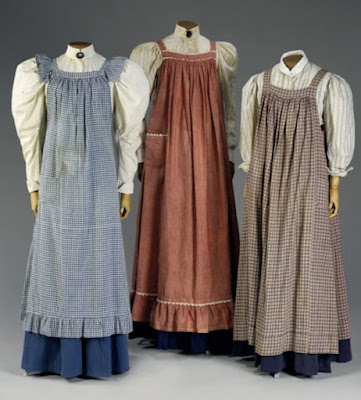Five Wrappers, c. 1895, made from the everyday fabrics we see in quilts at the time.
Been reading another fairly recently published textile history book: Real Clothes, Real Lives: 200 Years of What Women Wore by Kiki Smith with an introduction by Vanessa Friedman.
Catherine (Kiki) Smith is the curator of
Smith College Historic Clothing Collection.
Work aprons
The collection has over 4,000 pieces, acquired in the past few years. Unlike many other clothing collections Smith College's does not focus on designer wardrobes or celebrity-associated articles. Most of the objects seem to be undocumented, the more inexpensive kinds of wear that many of us interested in patchwork quilts might also collect.
Sundress (ca. 1950) of a print inspired by the musical South Pacific
That this collection focus is valuable and worth supporting would seem to be obvious, but five years ago Vanessa Friedman who wrote the introduction published a story in the New York Times asking
whether such a collection has any value."As the fate of the collection becomes a subject of debate within the college, it has stirred up uncomfortable questions about what constitutes 'value' in the context of clothes, the liberal arts and the current conversation about how we talk about women’s history."
The question seems snobbish and outdated but apparently we still need to address collecting women's history at the basic level.
Repair on a work dress ca. 1920
You'll enjoy the book and learn a lot about clothing and fabrics. E.g. Repairing nylon stockings. Eek!
Preview here:









How fantastic that "ordinary" clothing has a collection. Yes, we do need to save them. It's rather like houses - everyone wants to save the big fancy old mansions. The ordinary working people's homes, not so much. Yet those simple homes show far better how things really were. Something certain groups seem to have an issue with regarding what history is worthy of learning.
ReplyDeleteThanks for the link to the preview, I think my "buy this" list has just increased.
I read the book earlier this year and enjoyed it tremendously. I've recommended it to many. I'd love to see the collection in person.
ReplyDeleteP.S. This is the fashion/textile equivalent of Thomas Hubka's book How the Working Class Home Became Modern.
ReplyDeleteI bought this book and love reading it, especially everyday the entries on aprons.
ReplyDelete